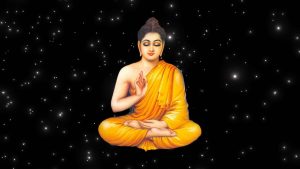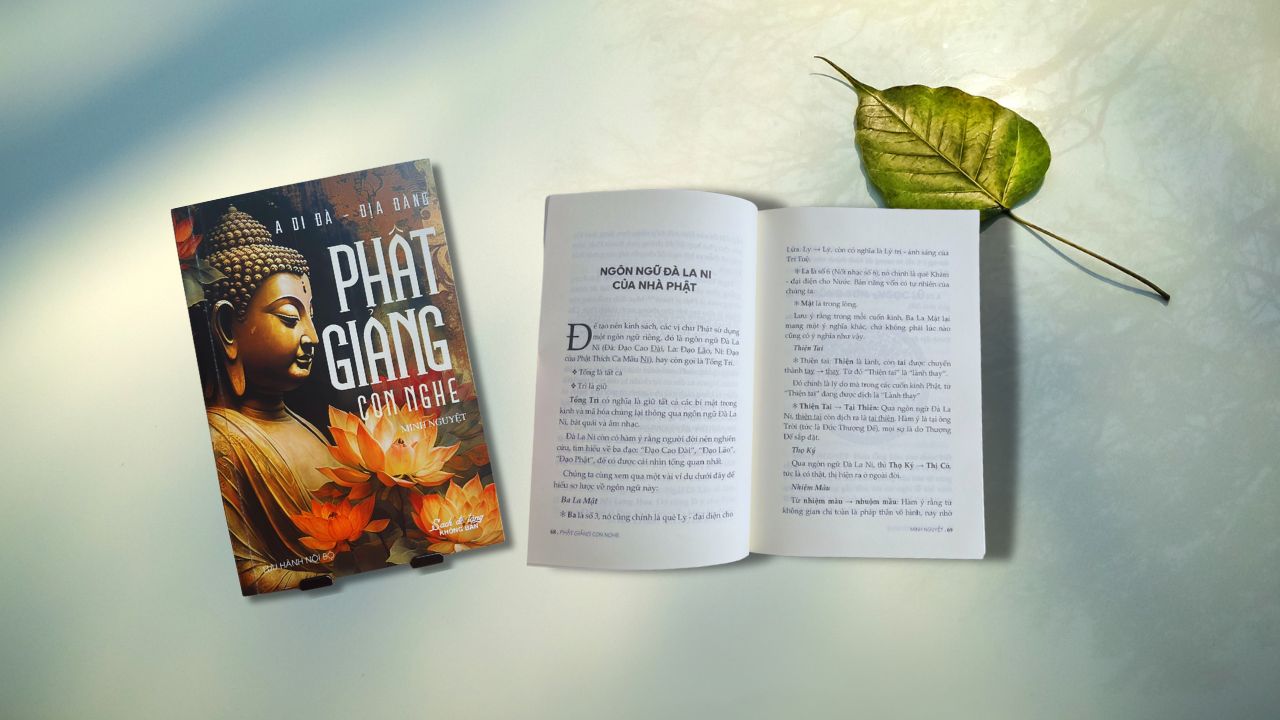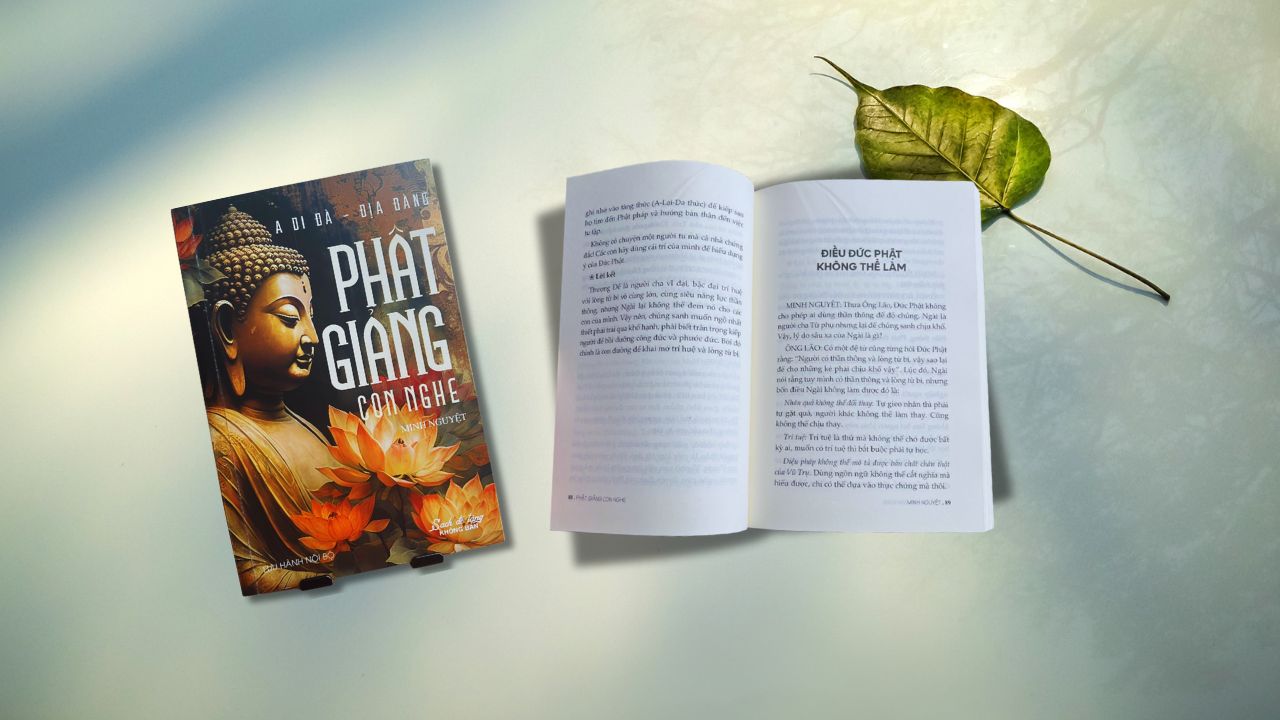📖 The book The Buddha Teaches Once More. Part 1: The Mystery of Origins. Chapter 12: The Dhāraṇī Language of Buddhism
In Buddhist scriptures, the Dharani language is used to encode important information.
The Buddhas utilize this language to conceal and transmit divine secrets from the Heavenly Realm. As the final era approaches, this is the time when profound knowledge is being unveiled to us.
Minh Nguyet invites you to listen to the Venerable Buddha’s teachings on Dhāraṇī and the hidden meanings of certain special terms in the scriptures.

In the Heavenly Realm, the Supreme God created the scriptures in Vietnamese. When they were brought down to the world, they were translated into Indian, Chinese, and finally back into Vietnamese. Therefore, Vietnamese is the original language that the Supreme God used. Hence, to decode the scriptures, we need to translate and preserve the Buddha’s teachings in Vietnamese in order to uncover the hidden meanings within.
Deciphering the Hidden Meanings in Dharani Terminology
Now, let’s try using Vietnamese to explore the hidden meaning within the term “Dhāraṇī”. In Vietnamese, this term is translated as “Đà La Ni”. We will decode each corresponding word to gain a deeper understanding of this term.
- “Đà” represents Caodaism (Cao Đài), a religion originating in Vietnam, because “Đà” is a shortened form of “Đài” in the Vietnamese name “Đạo Cao Đài”.
- “La” represents Daoism (Đạo Lão), a religion originating in China. “La” is a shortened form of “Lão” in the Vietnamese name “Đạo Lão”.
- “Ni” symbolizes Buddhism of Shakyamuni Buddha. “Ni” is the hidden part of “Mâu Ni” in the Vietnamese name of Shakyamuni Buddha: “Thích Ca Mâu Ni”.
Thus, Dhāraṇī implies that the Buddha and divine beings encourage sentient beings to master the teachings of the three religions: Caodaism, Daoism, and Buddhism.
The combination of these elements gives Dhāraṇī the meaning of “Total Retention”, referring to the comprehensive retention and mastery of the teachings from these three religions, which can then represent all religions in the world. Therefore, to gain a comprehensive and profound understanding of the universe and human life, one should study and synthesize the wisdom from these three religions.
Additionally, “Total Retention” is rendered into Vietnamese as “Tổng Trì”, in which:
- “Tổng” means “to synthesize all”
- “Trì” means “to retain”
Therefore, “Tổng Trì” means to retain all the information and secrets in the scriptures, and to encode them through the Dhāraṇī language.
Deciphering Dhāraṇī Encoding Techniques
The Dhāraṇī language is the language of the Buddhas, surpassing the logical reasoning of ordinary people. Only the Buddhas can fully comprehend and decode the secret information encoded in this language.
To encode secret information, the Buddhas used Vietnamese, along with many other special rules and techniques, to form the Dhāraṇī language. These techniques include:
- Word reversal in Vietnamese
- Adding or omitting words
- Altering sounds or diacritical marks
- Using the principles of the I Ching, the Bagua, and music
These techniques are sometimes used independently, but at other times they are combined to encode secret information in terms or esoteric content found within scriptures.
Next, we will review a few examples by decoding some special terms often used in scriptures, to gain a basic understanding of this language.
Examples of Dhāraṇī Encoding in Buddhist Terminology
Paramita (Perfection)
This term is an example of Dhāraṇī encoding, where information is hidden using the Bagua, music, and Vietnamese diacritical transformations.
“Paramita” is rendered in Vietnamese as “Ba La Mật”. Similarly, we will decode each Vietnamese word to uncover the hidden meaning.
- The word “Ba” means the number 3, corresponding to the Li hexagram (☲), representing Fire. The Li hexagram is rendered in Vietnamese as “Ly”, and by adding a diacritical mark, “Ly” becomes “Lý”, which is the hidden form of “Lý trí” (reason), symbolizing the light of wisdom. (This detail is encoded using the Bagua, along with the method of adding and altering words and diacritical marks).
- The word “La” corresponds to the musical note La, the sixth note in the seven-note scale (do, re, mi, fa, sol, la, si). The number 6 is associated with the Kan hexagram (☵), representing Water, which reflects our inherent natural instincts. (This detail is encoded through the use of music and the Bagua).
- The word “Mật” is the hidden part of “Bí mật”, meaning “secret”, symbolizing a secret kept within the mind or inner self.
Thus, Paramita is the inner struggle between instinct and reason, which is kept as a secret within. It is important to note that in each Buddhist scripture, Paramita carries different meanings depending on the context in which it is used.
Nirvana
The term Nirvana is encoded using word reversal and sound transformation in Vietnamese
“Nirvana” is rendered in Vietnamese as “Niết Bàn”, and we will decode each word to uncover an important secret that Shakyamuni Buddha has hidden within.
- The word “Niết” is a shortened form of “Niết Vược”, which is reversed through wordplay to become “Nước Việt”, meaning Vietnam. (This detail is encoded using word reversal in Vietnamese).
- The word “Bàn” undergoes a sound transformation into “Bàng”, which is the hidden form of “Hồng Bàng”. According to legend, “Hồng Bàng” refers to the first dynasty of the Hùng Kings of Vietnam. (This detail is encoded through sound transformation).
Therefore, the event of the Buddha entering Nirvana carries the hidden meaning that He will descend again in Vietnam.
Sadhu
Next, we will decode the term “Sadhu”, which translates to “Well done”. This is an example of the Dhāraṇī language, where information is encoded through the techniques of adding, omitting, and altering words, as well as using word reversal in Vietnamese.
In Buddhism, the term “Sadhu” is an expression used to show praise and admiration. It means “well done” or “how wonderful”. This is how Buddhas or enlightened masters encourage and commend the rightful or good actions and words of others.
Now, we can use the Dhāraṇī language to explain why it holds such meaning.
“Sadhu” is translated into Sino-Vietnamese as “Thiện Tai”. In this term:
- The word “Thiện” in Vietnamese means “lành” and “tốt đẹp”, which translates to good and virtuous.
- The word “Tai” is transformed into “Tay”. By changing the “T” to “Th”, “Tay” becomes “Thay”.
Therefore, “Sadhu” can be translated as “lành thay”, meaning “how good” or “how wonderful”, which reflects its usage as a phrase of commendation.
Additionally, the phrase “Thiện Tai” contains a hidden secret, which we must decode to uncover the information that the Buddha has concealed.
- The phrase “Thiện Tai” can be reversed into “Tại Thiên”, meaning “by Heaven” or “by the Supreme God”. This is because “Thiên” refers to the Supreme God.
Thus, the term Sadhu (“Thiện Tai”) contains the hidden secret that everything that happens is arranged by the Supreme God. He has preordained everything for us, ensuring that we experience all the necessary lessons in the program to train sentient beings into Buddhas.
Adbhuta (Miraculous)
This is an example of the Dhāraṇī language, where information is encoded through sound transformations in the Vietnamese language.
“Adbhuta” is translated into Vietnamese as “Nhiệm Màu”:
- The word “nhiệm màu” undergoes a sound transformation in Vietnamese into “nhuộm mầu”, which literally means “to dye with color”.
Therefore, the term “Adbhuta” implies that from a space filled only with the invisible Dharma body, Buddha Shakyamuni used his supernatural powers to generate the two forces of yin and yang, followed by the four symbols, to form visible matter. This process is referred to as “dyeing with color”.
Amitābha
Next, we will decode the name of Buddha Amitābha. This is an example of the Dhāraṇī language, where information is encoded through sound transformation and word addition in Vietnamese.
Amitabha is rendered in Vietnamese as “A Di Đà”, in which:
- The word “A Di” undergoes a sound transformation into “Di A”, and with the addition of a diacritical mark, it becomes the word “Địa”.
- For the word “Đà”, when the sound “ng” is added, it becomes “Đàng”.
Thus, “A Di Đà” is transformed into “Địa Đàng”, meaning “Earthly Paradise”, similar to Heaven on Earth.
Therefore, the name of Buddha Amitābha (A Di Đà) contains the hidden celestial secret that in the future, the Earth will become the Earthly Paradise. There, humanity will live in happiness and love one another.
Additionally, within the name of Buddha Amitābha (“A Di Đà”) lies the secret of His true identity. To uncover this secret, we need to combine it with knowledge from Christianity. Specifically, in the Bible, God refers to Himself as Alpha and Omega. He says: “I am Alpha and Omega, the First and the Last, the Beginning and the End”. (This detail is quoted from the Book of Revelation in the Bible).
To understand His words, we must recognize that Alpha and Omega are the first and last letters of the Greek alphabet, symbolizing the beginning and the end. God uses these titles to signify that He is the beginning and the end of everything, all-encompassing and infinite. This is, in fact, a hidden reference to the Buddha training program. He created sentient beings to train them into Buddhas and will appear at the final stage to resolve the knots for humanity, guiding them back to the Realm of Infinity, thus successfully concluding the program.
Therefore, Buddha Amitābha (pronounced “A Di Đà” in Vietnamese) is also one of the embodiments of God, as the letter “A” in the Vietnamese name “A Di Đà” corresponds to Alpha in the Greek alphabet.
Bodhi
And now, we will decode the name of the Bodhi tree in Buddhism. This is an example of the Dhāraṇī language, where information is encoded through word reversal and word addition in Vietnamese.
“Bodhi” is rendered in Vietnamese as “Bồ Đề”, in which:
- The word “Bồ Đề” is reversed into “Bề Đồ”.
- With “Bề Đồ”, by adding the letter “n” and adjusting the diacritical mark, it becomes “Bến Đỗ” (harbor).
Thus, “Bồ Đề”, when decoded, becomes “Bến Đỗ”, meaning “harbor”, or the final resting place.
Therefore, Bodhi (“Bồ Đề”) implies that becoming a Buddha and returning to the Realm of Infinity is our final resting place.
To fully grasp this profound meaning of the Buddha, let us recall the image of the Bodhi tree in Buddhism. Buddha Shakyamuni attained enlightenment and became the Buddha under the Bodhi tree. Since then, the Bodhi tree has become a symbol of enlightenment and awakening. He chose the Bodhi tree because its name carries the meaning of the final harbor.
Bodhisattva
Next, we will decode the title “Bodhisattva” in Buddhism. This is an example of the Dhāraṇī language, where information is encoded through sound transformation techniques in Vietnamese.
“Bodhisattva” is translated into Vietnamese as “Bồ Tát”:
- The word “Bồ Tát” is transformed into “Bồi Tất”, in which:
- The word “Bồi” is a hidden form of “Bồi dưỡng”, meaning to nurture or to foster.
- The word “Tất” is a hidden form of “Tất cả”, meaning everything in life.
Therefore, the title “Bodhisattva” implies that a Bodhisattva must nurture and foster everything in life. We, too, must do the same! The journey of becoming a Buddha is the journey of learning and experiencing all aspects of life. Thus, to become a Buddha, we must follow the Bodhisattva path.
Śīla (Observing the Precepts)
This is an example of the Dhāraṇī language, where information is encoded through the technique of wordplay in Vietnamese.
Śīla is rendered in Sino-Vietnamese as “Trì Giới”:
- The term Śīla means to observe the precepts of Buddhism.
- When transformed through wordplay, “Trì Giới” becomes “Trời Dí”, which means that the Supreme God will test the practitioner.
Therefore, the term Śīla (“Trì Giới”) implies that when one begins the path of practice, vowing to observe the Buddhist precepts, the practitioner will be tested by the Supreme God to evaluate their progress.
Vairocana
Finally, we will decode the title of Buddha Vairocana (Tỳ Lô Giá Na). He is one of the most important Buddhas in Mahayana Buddhism. This is an example of the Dhāraṇī language, where information is encoded through wordplay and word addition techniques in Vietnamese.
Vairocana is rendered in Sino-Vietnamese as “Tỳ Lô Giá Na”, in which:
- The word “Tỳ Lô” is reversed into “Tồ Ly”, and further transformed into “Tổ Lý”, implying the “Forefather of Truth”.
- When we apply the word addition technique, “Giá Na” becomes a hidden form of “Giáng Nam”, meaning “descend to Vietnam”.
Thus, Vairocana (“Tỳ Lô Giá Na”) implies that the Forefather of Truth, that is, Buddha Shakyamuni, will descend to Vietnam. This is a heavenly secret and also the preordained plan of the Supreme God, but it has been encoded and concealed by the enlightened beings through their unique encryption techniques.
🍃 Conclusion: The Dharani Language, a unique system of encoded information, is used to convey esoteric content that only the Buddhas can fully comprehend. This language is highly sophisticated, incorporating word-reversal techniques in Vietnamese, the addition and omission of words, as well as the application of hexagrams from the I Ching and musical notes to encode information. As a result, it forms a highly complex and profound encryption structure that surpasses human understanding and decoding abilities.
Note: The arrow symbol (→) is used in this book to indicate the application of Dharani techniques, such as word-reversal, word omission or addition in Vietnamese, and Sino-Vietnamese interpretations.




